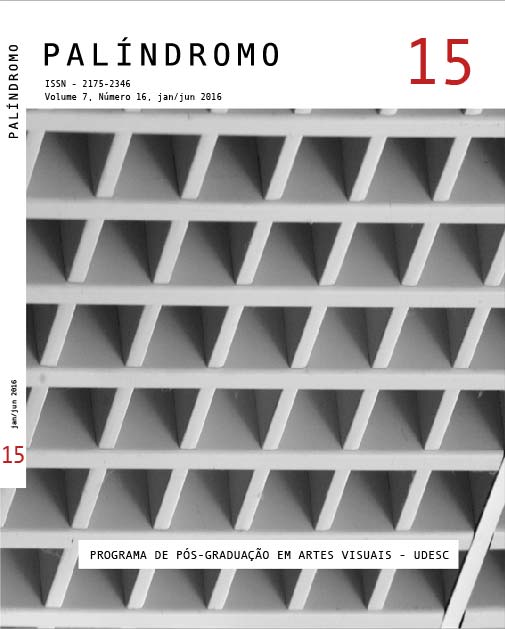EPISTEMOLOGY OF ART: THE FRUITION AND ART OBJECT
DOI:
https://doi.org/10.5965/2175234608152016004Keywords:
epistemology, objectivity, dubjrctivity, fruition , art objectAbstract
In this article, we present a perspecti- ve on the subject / object, spectator / object ofart relations, reflected through the prism of the implications present in the meaning- making process of image reading. The men- tioned considerations are woven from the art object, translatedthrough the multiplicity of possible readings. These readings emphasize subjectivity as volition,however, expounding from paths of objective significance. To ex- plain this relationship, we firstexplain the ex- pressive character of the need for reason as part of the process that brings outmeaning, considering the extreme conceptual and real content of the multiple facets of the artob- ject, merged with critical ethical content. The second part of the thesis holds that art is delineated by a conceptual space, formed from the subjectivity that begins in the sub- ject that sets up the object. In this context, art objects point to the subjectivity of the artist and the spectator in the construction of meaning, through an elaborate creation process. The counterpart to this process is based on the objectivity of the real mate- rial object , which reverberates through the conceptual repertoire of the subject. We also bring to this context the autonomy present in the construction of conceptual significan- ce as substrate possible truths, in order to delineate significant areas.
Downloads
References
ABAGNANO, N. Dicionário de Filosofia. Trad. Alfredo Bossi. 5 ed. São Paulo: Martins Fontes, 2007.
ADORNO, T. Negative dialectics. New York: The Continuum Publishing Company, 1999.
BAUDRILLARD, J. O sistema dos objetos. Trad. Zulmira R. Tavares. São Paulo: Ed. Pers- pectiva, 1973.
BODEN, M. A. Dimensões da criatividade. Trad. Pedro Theobald. Porto Alegre: Ed. Artes Médicas, 1999.
BODEN, M. A. Life and cognitio. In: Branquinho, J. In: The foundations of cognitive science. Oxford: Claredon Press, 2001.
BOHM, D. Totalidade e Ordem Implicada. Trad. Teodoro Lorent. São Paulo: Madras, 2008.
CALCATERRA, R. M. Ideias concretas: percurso na filosofia de John Dewey. Trad. Sil- vana C. Leite. São Paulo: Edições Loyola, 2015.
GOSWAMI, A. Criatividade Quântica: Como pensar nosso potencial criativo. Trad. Cássia Nasser e Marcello Borges. São Paulo: Aleph, 2008.
HANSON, R. N. Patterns of Discovery. Cambridge: Cambridge University Press, 1972. OLIVEIRA, N. R. de.; ZUIN, A.A.S.; PUCCI, B. Teoria Crítica, estética e educação. Cam- pinas: Editora Autores Associados, 2001
PEIRCE, C. S. Collected Papers of Charles Sanders Peirce. Ed. Hartshorne, Weiss & Burks. Cambridge: Harvard Univ. Press, 1935, 1958.
PEIRCE, C. S. Semiótica. Trad. José Teixeira Coelho Neto. São Paulo: Perspectiva, 1995 PEIRCE, C. S. Um argumento negligenciado para a realidade de Deus. Trad. Cassiano Terra. In: Revista Cognitio, v.4, n. 1, 2003.
SANTAELLA, L. Matrizes da linguagem e pensamento: sonora, visual, verbal - Aplica- ções na hipermídia. 3 ed. São Paulo: Iluminuras: FAPESP, 2005.
SILVEIRA, L.F.B. Curso de semiótica geral. São Paulo: Quartier Latin, 2007.
Downloads
Published
How to Cite
Issue
Section
License
Copyright (c) 2016 Tiziana Cocchieri

This work is licensed under a Creative Commons Attribution 4.0 International License.
COPYRIGHT STATEMENT
The articles published by the magazine are free to use, intended for academic and non-commercial applications. Copyright is all assigned to the magazine. The articles whose authors are identified represent the expression from the point of view of their authors and not the official position of Palíndromo Magazine. The author (s) commits to whenever they publish material referring to the article published in Palíndromo mention this publication as follows:
This article was originally published by Palíndromo magazine in its volume (place the volume), number (place the number) in the year of (place the year) and can be accessed at: http://www.revistas.udesc.br/index.php/palindromo


